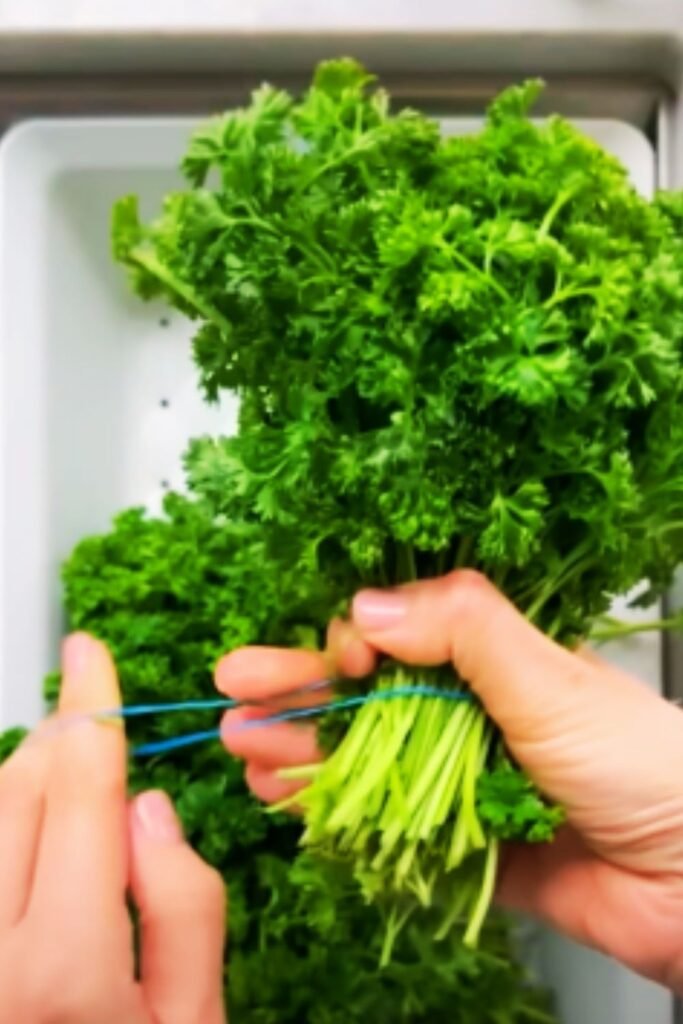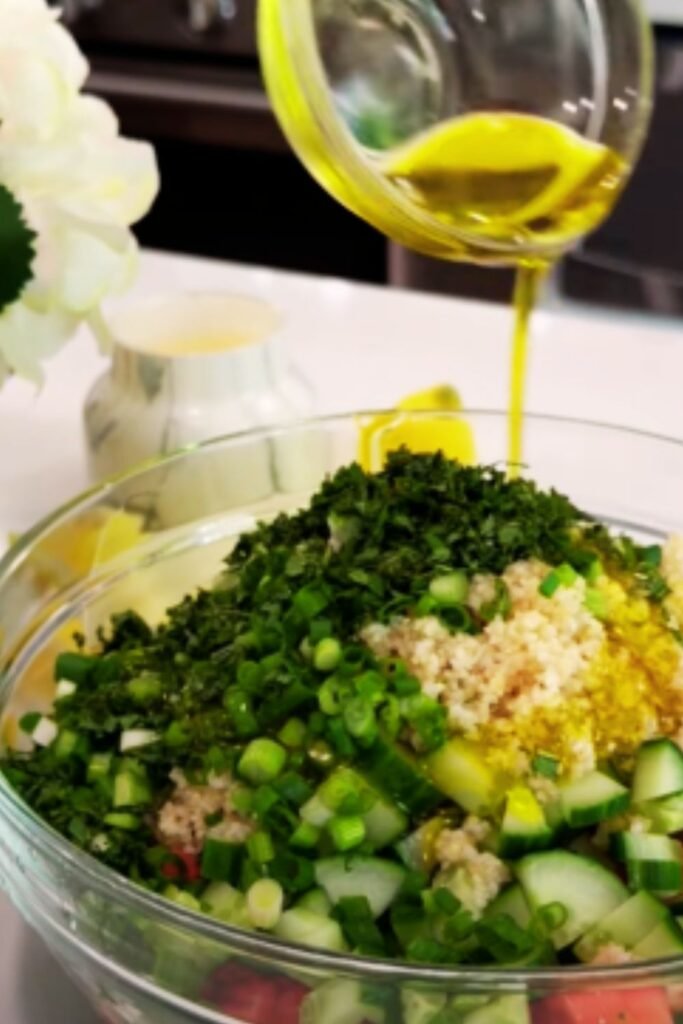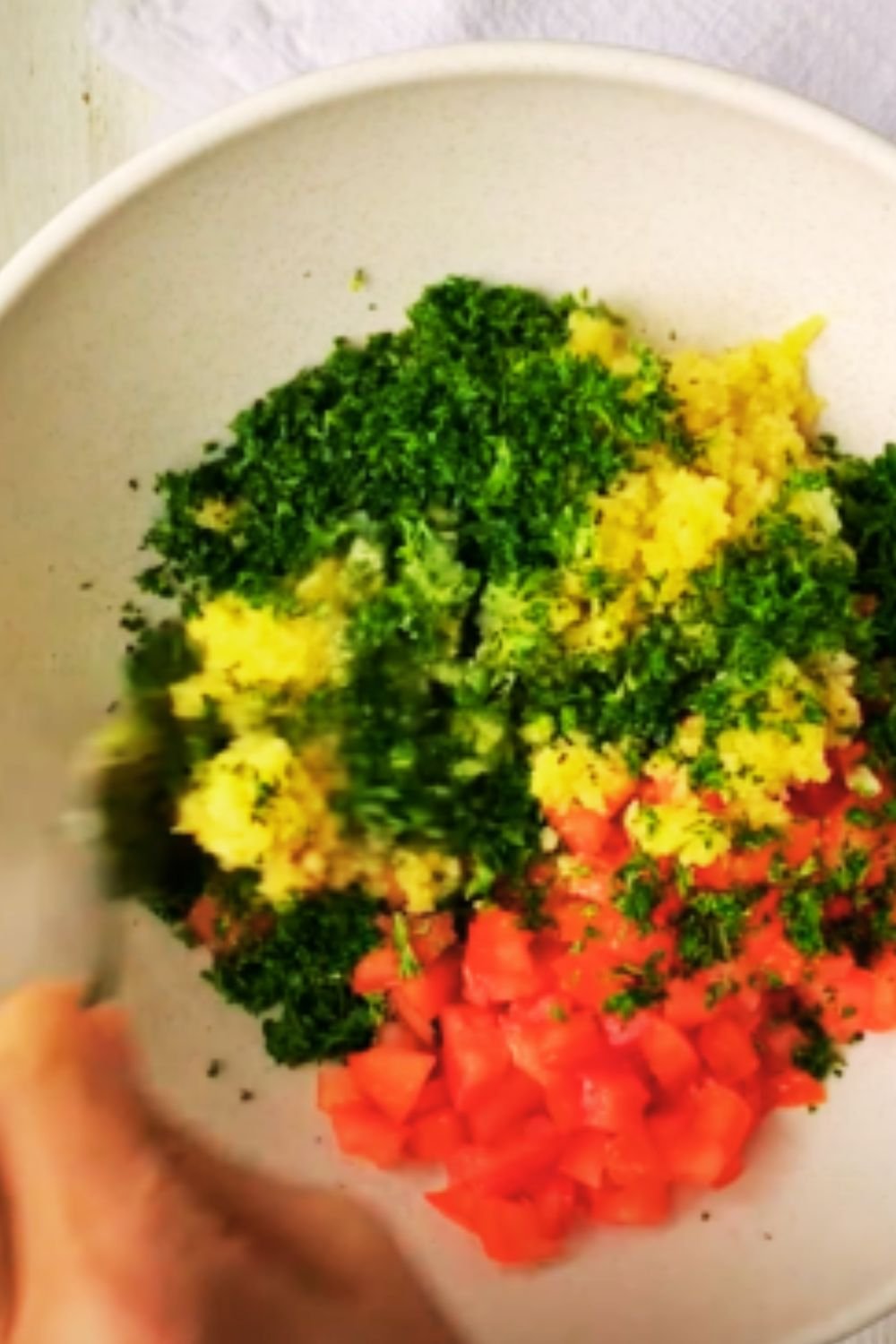Tabbouleh is one of those dishes that takes me back to warm summer evenings spent around my grandmother’s table. This vibrant Lebanese salad bursts with fresh flavors and has become a staple in my kitchen for good reason. Whether you’re looking for a light lunch, a stunning side dish, or an impressive addition to your mezze spread, tabbouleh delivers on all fronts with its perfect balance of herbs, bulgur, and tangy dressing.
What is Tabbouleh?
Tabbouleh (also spelled tabouli or tabouleh) is a traditional Levantine salad that originated in the mountains of Lebanon and Syria. Unlike many Western salads that use lettuce as a base, tabbouleh celebrates fresh parsley as its star ingredient, complemented by mint, tomatoes, and bulgur wheat, all dressed with lemon juice and olive oil.
In authentic Lebanese tabbouleh, parsley is the dominant ingredient—not bulgur wheat as some Western adaptations might suggest. The bulgur provides texture and substance but should be used sparingly. This herb-forward approach creates a remarkably fresh, light dish that works perfectly as part of a mezze spread or as a palate-cleansing side dish.
The Health Benefits of Tabbouleh
I’m always looking for dishes that are both delicious and nutritious, and tabbouleh certainly fits the bill. This powerhouse salad offers numerous health benefits:
- Rich in Antioxidants: Parsley is packed with vitamins A, C, and K, as well as flavonoids that help fight inflammation.
- Heart-Healthy: The olive oil provides beneficial monounsaturated fats.
- High in Fiber: Bulgur wheat is a whole grain that supports digestive health.
- Low in Calories: Perfect for those watching their weight without sacrificing flavor.
- Hydrating Properties: The high water content from the vegetables makes this a refreshing choice on hot days.
The combination of fresh herbs and vegetables provides a nutrient-dense meal that satisfies both the palate and the body’s nutritional needs.
Essential Ingredients for Authentic Tabbouleh
Creating authentic tabbouleh requires attention to both the quality and proportion of ingredients. Here’s what you’ll need:
Core Ingredients
- Flat-leaf parsley: The foundation of tabbouleh, providing both color and flavor
- Fresh mint leaves: Adds a cooling, aromatic quality
- Bulgur wheat: Provides texture and subtle nutty flavor
- Ripe tomatoes: Contributes juiciness and acidity
- Spring onions or red onion: Offers a mild bite
- Fresh lemon juice: The acidic component of the dressing
- Extra-virgin olive oil: The rich, fruity element of the dressing
- Salt and freshly ground black pepper: Essential seasonings
Optional Additions
While traditional tabbouleh has a fairly specific ingredient list, there are some acceptable variations:
- Cucumber: Adds extra crunch and freshness
- Pomegranate seeds: Provides bursts of sweetness and color
- Sumac: A tangy Middle Eastern spice that complements the lemon
- Fresh garlic: For a more assertive flavor profile
The beauty of tabbouleh lies in its simplicity, so I recommend starting with the traditional recipe before experimenting with additions.
Bulgur vs. Other Grains: Making the Right Choice
Bulgur wheat is essential to authentic tabbouleh, but understanding the different types and possible substitutions can help you customize the dish to your needs.
| Grain Type | Description | Cooking Time | Best For | Texture in Tabbouleh |
|---|---|---|---|---|
| Fine Bulgur (#1) | Smallest grain size | No cooking required, just soaking | Traditional tabbouleh | Soft, blends seamlessly |
| Medium Bulgur (#2) | Medium grain size | 5-10 minutes cooking | Everyday tabbouleh | Slightly more noticeable |
| Coarse Bulgur (#3) | Largest grain size | 15-20 minutes cooking | Heartier salads | Distinctly chewy |
| Quinoa | Gluten-free alternative | 15 minutes cooking | Gluten-free tabbouleh | Smaller, pop-in-mouth texture |
| Couscous | Pasta alternative | 5 minutes steaming | North African variation | Uniform, soft texture |
| Cauliflower Rice | Low-carb alternative | Brief sautéing | Keto/low-carb tabbouleh | Light, vegetable-forward |
For authentic tabbouleh, fine bulgur is the traditional choice as it absorbs the flavors of the dressing without requiring cooking. Simply rinse it and let it soak in the dressing while you prepare the other ingredients.
Step-by-Step Tabbouleh Preparation
Creating perfect tabbouleh is all about technique and balance. Follow these steps for the best results:
1. Prepare the Bulgur
- Rinse 1/4 cup fine bulgur wheat under cold water
- Place in a bowl and cover with water
- Let soak for 20-30 minutes until softened
- Drain thoroughly and squeeze out excess water
2. Prep the Herbs
- Wash 3 large bunches of parsley and 1 bunch of mint thoroughly
- Dry completely using a salad spinner or clean kitchen towels
- Remove tough stems from parsley and mint
- Finely chop the herbs—this is best done by hand for the right texture
3. Prepare the Vegetables
- Dice 4 ripe tomatoes into small cubes
- Finely slice 4-5 spring onions or 1/2 a red onion
- If using cucumber, remove seeds and dice finely
4. Make the Dressing
- Combine the juice of 2-3 lemons (about 1/4 cup)
- Add 1/3 cup extra-virgin olive oil
- Season with 1 teaspoon salt and 1/4 teaspoon freshly ground black pepper
- Optional: add 1/2 teaspoon sumac for extra tanginess
5. Combine and Marinate
- In a large bowl, combine the drained bulgur with the dressing
- Add the chopped herbs and vegetables
- Toss gently but thoroughly to combine
- Let stand at room temperature for 15-30 minutes to allow flavors to meld

Common Mistakes to Avoid When Making Tabbouleh
Even simple dishes have their pitfalls. Here are some common mistakes I’ve encountered (and sometimes made myself) when preparing tabbouleh:
- Using too much bulgur: Remember, tabbouleh is primarily an herb salad. Keep the bulgur to a modest amount—about 1/4 cup dry bulgur for a large salad serving 4-6 people.
- Not drying the herbs properly: Wet herbs will make your salad soggy. Take the time to thoroughly dry parsley and mint after washing.
- Chopping in a food processor: This often results in bruised, mushy herbs. Hand chopping gives you the perfect texture and releases the herbs’ aromatic oils.
- Not allowing time for flavor development: Tabbouleh benefits from at least 15-30 minutes of sitting time before serving, allowing the bulgur to absorb the dressing and the flavors to meld.
- Serving cold from the refrigerator: Tabbouleh tastes best at room temperature when the flavors are most pronounced.
- Using bottled lemon juice: The fresh, bright flavor of real lemons is essential to authentic tabbouleh.
- Under-seasoning: Don’t be shy with the salt and lemon juice—these elements bring all the flavors together.
Regional Variations of Tabbouleh
While Lebanese tabbouleh is the most widely recognized version, there are fascinating regional variations worth exploring:
Lebanese Tabbouleh
The classic version with an emphasis on finely chopped parsley and minimal bulgur.
Turkish Kisir
Features more bulgur and less parsley, often including pomegranate molasses and sometimes hot pepper paste.
Armenian Eetch
Served warm with more bulgur and tomato paste, creating a richer, heartier dish.
Palestinian Variation
Often includes cucumber and sometimes romaine lettuce leaves as serving vessels.
Western Adaptation
Many Western interpretations increase the proportion of bulgur, creating a grain salad with herbs rather than an herb salad with grains.
I find it fascinating how one dish can evolve as it crosses borders, adapting to local tastes and available ingredients while maintaining its essential character.
Serving Suggestions and Pairings
Tabbouleh is wonderfully versatile when it comes to serving options:
Traditional Serving Methods
- Served on romaine lettuce leaves used as edible scoops
- As part of a mezze spread alongside hummus, baba ganoush, and pita
- Accompanied by grilled halloumi cheese
- With falafel in pita bread for a complete vegetarian meal
Modern Pairings
- Alongside grilled chicken, lamb, or fish
- In a Mediterranean grain bowl with roasted vegetables
- As a filling for stuffed bell peppers
- Topped with crumbled feta cheese for added richness
Complementary Beverages
- Lemon-mint infused water
- Sparkling water with a splash of pomegranate juice
- Iced tea with fresh mint
- Fresh lemonade

Make-Ahead and Storage Tips
One of the things I love about tabbouleh is its make-ahead potential, though with some important caveats:
Short-Term Storage (1-2 days)
For the best flavor and texture, I recommend preparing components separately if you’re making tabbouleh in advance:
- Herb Base: Wash, dry, and chop the parsley and mint up to 24 hours ahead. Store in an airtight container lined with paper towels.
- Bulgur: Prepare and drain the bulgur and store separately.
- Vegetables: Dice tomatoes and onions and store separately.
- Dressing: Mix and store in a jar in the refrigerator.
- Final Assembly: Combine all elements 15-30 minutes before serving.
Longer Storage (2-3 days)
If you must store fully assembled tabbouleh:
- Store in an airtight container in the refrigerator
- Do not add tomatoes until ready to serve, as they release moisture that will wilt the herbs
- Bring to room temperature before serving
- Refresh with additional lemon juice and olive oil before serving
Freezing
Tabbouleh does not freeze well due to its high proportion of fresh herbs and vegetables. I recommend making only what you’ll consume within a few days.
Tabbouleh Nutritional Profile
For those watching their nutritional intake, here’s a breakdown of what tabbouleh offers:
| Nutrient | Amount per 1 Cup Serving | % Daily Value |
|---|---|---|
| Calories | 178 | – |
| Total Fat | 11g | 14% |
| Saturated Fat | 1.5g | 8% |
| Sodium | 287mg | 13% |
| Total Carbohydrates | 18g | 7% |
| Dietary Fiber | 4g | 14% |
| Sugars | 2g | – |
| Protein | 3g | 6% |
| Vitamin A | – | 75% |
| Vitamin C | – | 62% |
| Vitamin K | – | 230% |
| Folate | – | 21% |
| Iron | – | 15% |
This nutritional profile makes tabbouleh an excellent choice for those following Mediterranean, vegetarian, or plant-based diets. The high vitamin content—particularly vitamin K from the parsley—supports bone health, while the fiber from the bulgur and vegetables promotes digestive wellness.
My Favorite Tabbouleh Recipe
After years of making tabbouleh, I’ve developed what I consider to be the perfect balance of ingredients. This recipe serves 4-6 people as a side dish.
Ingredients:
- 3 large bunches flat-leaf parsley (about 3 cups finely chopped)
- 1/2 cup fresh mint leaves, finely chopped
- 1/4 cup fine bulgur wheat
- 4 medium tomatoes, diced small
- 5 spring onions, finely sliced
- 1/3 cup extra virgin olive oil
- Juice of 2-3 lemons (about 1/4 cup)
- 1 teaspoon sea salt
- 1/4 teaspoon freshly ground black pepper
- Optional: 1/2 teaspoon sumac
- Optional: 1 small cucumber, seeded and diced
Method:
- Rinse the bulgur in a fine-mesh sieve until the water runs clear. Place in a bowl, cover with cold water, and let soak for 20-30 minutes.
- Meanwhile, wash the parsley and mint thoroughly and dry completely. Remove any tough stems, then finely chop by hand—aim for pieces about the size of rice grains.
- Dice the tomatoes small, removing excess seeds and juice. Finely slice the spring onions.
- Drain the bulgur thoroughly, squeezing out any excess water. Transfer to a large mixing bowl.
- Add the chopped herbs, tomatoes, and spring onions to the bowl.
- In a separate small bowl, whisk together the lemon juice, olive oil, salt, pepper, and sumac if using.
- Pour the dressing over the salad and toss gently but thoroughly to combine.
- Let the salad stand at room temperature for 15-30 minutes before serving to allow the flavors to develop.
- Taste and adjust seasoning if needed, adding more lemon juice or salt as desired.
- Serve at room temperature, ideally in a shallow bowl or platter to showcase the vibrant colors.

Creative Tabbouleh Variations
While I’m a purist at heart when it comes to tabbouleh, I occasionally enjoy these creative variations:
Quinoa Tabbouleh
Perfect for those avoiding gluten, cooked and cooled quinoa provides a protein boost while maintaining a similar texture to bulgur.
Cauliflower Tabbouleh
For a low-carb option, finely chopped cauliflower replaces the bulgur, creating an even lighter salad that’s keto-friendly.
Fruit-Enhanced Tabbouleh
Adding pomegranate seeds or diced apple brings a sweet-tart dimension that works surprisingly well with the herbs.
Spiced Tabbouleh
Adding ground cumin, cinnamon, or Aleppo pepper creates depth and warmth—particularly good in cooler months.
Grain-Free Tabbouleh
For a completely grain-free option, use chopped nuts like almonds or walnuts for texture and protein.
The beauty of these variations is that they maintain the spirit of tabbouleh—fresh, bright, and herb-forward—while adapting to different dietary needs or preferences.
Questions & Answers About Tabbouleh
Q: Can I make tabbouleh without bulgur wheat? Absolutely! For gluten-free options, you can substitute quinoa, millet, or cauliflower rice. The herb mixture is really the star of this dish, so the grain component can be flexible.
Q: How far in advance can I make tabbouleh? For the best flavor and texture, I recommend preparing the components separately up to 24 hours ahead, then combining them about 30 minutes before serving. If you need to make the complete salad ahead, it will keep for about 1-2 days in the refrigerator, though the herbs may wilt somewhat.
Q: Why is my tabbouleh soggy? Soggy tabbouleh usually results from not drying the herbs thoroughly after washing, not draining the bulgur properly, or adding too much dressing. Make sure to spin your herbs completely dry and squeeze excess water from the bulgur before mixing.
Q: Can I use curly parsley instead of flat-leaf? While traditional tabbouleh uses flat-leaf (Italian) parsley for its softer texture and stronger flavor, curly parsley will work in a pinch. The flavor is milder, so you might want to adjust other seasonings accordingly.
Q: How do I know if my tabbouleh has the right proportions? Authentic tabbouleh should look predominantly green, with the chopped parsley as the main visual element. The bulgur should be present but not dominant—think of it as a supporting ingredient rather than the base of the salad.
Q: Is tabbouleh served warm or cold? Tabbouleh is traditionally served at room temperature, which allows the flavors to shine. If you refrigerate it, I recommend letting it sit out for about 15-30 minutes before serving.
Q: Can I add garlic to tabbouleh? While not traditional, a small amount of very finely minced garlic can add depth to the dressing. Start with just one small clove, as too much can overpower the delicate herb flavors.
Q: How finely should I chop the herbs? The herbs should be chopped finely but not minced to a paste. Aim for pieces about the size of rice grains—small enough to blend well with other ingredients but large enough to maintain their texture and visual appeal.
Final Thoughts on Tabbouleh
Tabbouleh represents everything I love about Mediterranean cuisine—simple, fresh ingredients combined thoughtfully to create something far greater than the sum of its parts. The vibrant green of the parsley, the subtle texture of the bulgur, and the bright acidity of lemon create a perfectly balanced dish that has stood the test of time for good reason.
Whether you stick to the traditional Lebanese preparation or experiment with modern variations, tabbouleh offers a refreshing alternative to heavy sides and an opportunity to showcase fresh herbs at their best. It’s a dish that connects us to centuries of culinary tradition while fitting perfectly into contemporary healthy eating patterns.
I encourage you to make tabbouleh your own while respecting its herb-forward nature. Play with the proportions, try different grains, or add your personal touches—but always keep that essential freshness that makes tabbouleh so special. Your taste buds, and your dinner guests, will thank you.


